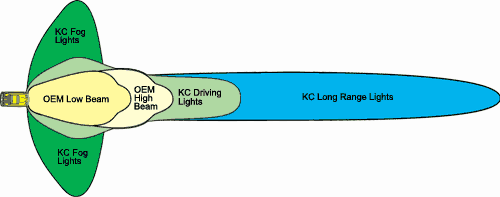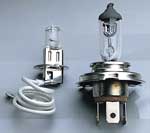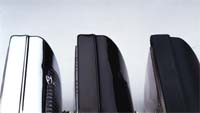A well-equipped vehicle will have three types of lighting: Fog lights, Driving lights, and Long range lights. Fog Lights produce a wide, low beam to get under extreme weather conditions. Driving lights are an improvement over stock headlights, burning brighter and shining farther through the dark. Long Range lights are generally for off road applications only, and complete the performance lighting picture, throwing high intensity light that projects up to 1.5 miles.
The standard headlights that come equipped on vehicles from the factory provide adequate illumination under ideal circumstances. When weather conditions deteriorate or when driving on long open stretches of interstate highways, auxiliary lighting can be very helpful. The illustration below gives a relative comparison of the beam patterns as seen from above. |
Bulbs/Wattage - Measured in watts; higher wattage means brighter light. With the exception of HID systems (see below), which project the brightest beam available at relatively low wattage.)

Sealed Beam (Incandescent)
The vacuum sealed beam is the standard automotive light source. For many applications such as marine, it remains very popular due in part to its complete atmospheric sealing which keeps water and condensation away from the interior of the light, as well as the greater selection of wattage and candlepower available. Color temperature is approximately 2700° K.
Quartz Halogen

A very widely used light source due to its relatively low bulb cost, ease of replacement, and whiter light temperature of approximately 3000° K.
H.I.D. High Intensity Discharge
This type of automotive lighting technology uses mercury and xenon gases to create and maintain a light source. These two gasses are ignited by applying 30,000 volts of current to two electrodes within a very small glass tube.
Lens
Most critical in determining clarity, focus, and beam pattern of any light. Plastic lens are common in low power lights; glass lens are required for high-power lights.

Amber or Clear?
Clear lens pass more light to let you see better. Amber lens provide more contrast and let the other drivers see you sooner. Amber is more easily seen in fog or snow.

Housing
Casing which contains the bulb and lens. Can be made of ABS plastic, aluminum, chromed steel or stainless steel. Some housings have "shock mounting" for severe conditions.











